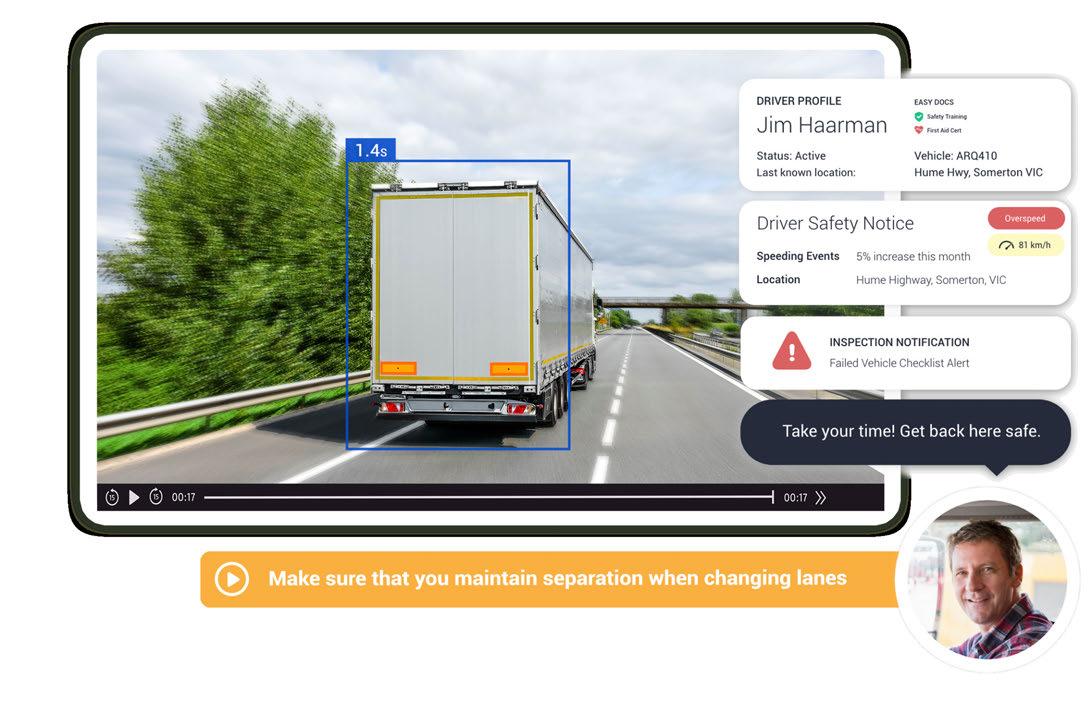
4 minute read
Golden partnership with Prime Creative Media
be presented later in the year, this will be an award for an outstanding woman under-30 working in any capacity in the transport industry.
WITH the Transport Women Australia Limited planning weekend over, we have set most of the plans in motion for the remainder of 2023 and started planning for the conference for 2024.
We have chosen our speakers and panellists for International Women’s Day events, planned the Learning Initiatives breakfast series and set the dates for most of our EOY functions.
We have chosen the dates for the 2024 conference which has been extended to a full two days and have commenced looking for a venue. Expressions of interest to present at the conference or to sponsor an event, a session or be the major conference sponsor can be sent to chair@transportwomen.com.au
We are also seeking a sponsor for a new award to
We have some exciting news plans in the coming months, the second version of our video is set to be released, we have the Transport Woman Unite Red Ball in Alice Springs, www.roadtransporthall.com and follow the ‘book now’ prompts for tickets; our wonderful Brisbane Truck Show breakfast www.trybooking.com/CFBSJ and the pre Trucking Australia lunch, and much more.
We are nominating members in the RFNSW and the ATA awards, as well as Women in Industry awards. We will be nominating for others as nominations open, it is so great that we have such depth in the membership that we can showcase our members in this way.
TWAL have just announced a gold partnership with Prime Creative Media and will be announcing the second partnership in the coming weeks.
We are so proud of our relationship with Prime Creative and look forward to working with them in the years ahead. This has been a very exciting beginning to 2023 and I’m looking forward to sharing all the good news with you as it happens.
When I was at Koroit, flying the TWAL flag at the annual truck show on January 28, we were playing Australian Truck Radio and it gave our vice chair Coralie Chapman and I such a thrill to hear TWAL song Living the Dream playing over the radio station.
In the past few weeks, I have returned to my roots in the livestock transport industry and I will be hearing much more of Australian Truck Radio as I travel between Melbourne and Wodonga every week and I look forward to sharing more on Australian Truck Radio as time progresses.
With the Foundation Business Partners NTI and Volvo Group Australia, our Gold Partner, Prime Creative Media, and our Driving the Difference scholarship sponsor, Daimler Truck Australia Pacific, the Trish Pickering Memorial Award sponsor,

Wes Pickering and of course all other sponsors who support us throughout the year by sponsoring events, raffles, lucky door prizes amongst other things and who are too numerous to mention in this one article, we are now able to do much more.
And of course, with our wonderful supportive members and they’re ongoing membership we can only go from strength to strength. I am truly grateful to everyone out there who supports us every day. We hope to see you at an event very soon.
DURING the past 10 years as Australia’s heavy vehicle regulator, we’ve learnt a lot about driver fatigue, and one thing in particular that stands out is the need to better recognise individual driver needs.

The prescriptive (or standard hours) approach to fatigue will always be available for those in industry who want to use it, and it’s long been an accepted community standard.
However, just like all other aspects of your business, fatigue is an area where you can invest in tailoring a solution to better suit your business and individual driver needs.
Advanced Fatigue Management (AFM) can provide operators with a tailored approach to work and rest hours, provided they put in place additional controls and offsets to manage fatigue safety risks.
Effectively managing fatigue – and underpinning AFM – is a business’s genuine commitment to work with its drivers to better understand their needs and to put safety first.
Under tailored fatigue options, drivers can have better quality rest periods, are working when they’re most alert, and can take more rest in a shift if they need to.
Indeed, from our data, we know that AFM is typically used to get drivers to somewhere where they can get better quality rest at the end of their shift.


Even though AFM has been around for a long time, we’re aware that some operators may be put off by the amount of paperwork and process involved in seeking accreditation.
To help address this, we’ve launched a dedicated project to remove unnecessary admin- istrative barriers and make the process more user-friendly for businesses of all sizes.

Through this AFM improvement project, we’ll be sharing examples of the types of tailored options that other companies are currently using, so operators can decide whether there’s a pre-made example of hours that would suit their business.

We’ll also be sharing the types of controls and offsets operators can use to man- age fatigue risks. There’ll be a library to choose from, and we’ll provide guidance on which best manages a particular risk.
We’ll be providing a collection of templates and tools for operations manuals, and other required safety systems, that operators can implement in their business – just like with our approach to Safety Management Systems.
In addition, the AFM application form will move to the NHVR Portal, and there’ll be a built-in risk calculator, into which applicants will simply have to enter what hours they need to work.
Importantly, we’ll have a dedicated AFM case manager to step applicants though the process.
Over the coming months, we’ll release more information about how industry can get involved in AFM using the new process.
I also recommend reading our Regulatory Advice – Fitness to drive: Fatigue , which provides guidance to all parties in the Chain of Responsibility on managing fatigue in the heavy vehicle transport industry and outlines their obligations under the HVNL. Our free Safety Management System guidance material also provides tools and templates to help operators assess their fatigue safety risks and communicate effectively with their employees about their fitness for duty.
I look forward to keeping you up to date with the progress of our AFM improvement project, and contributing to safer drivers on safer roads.










